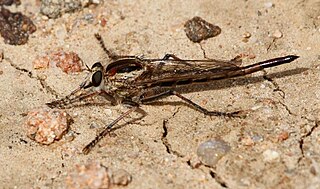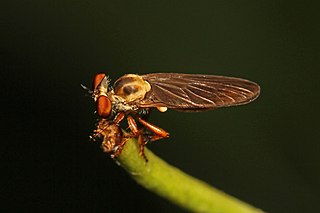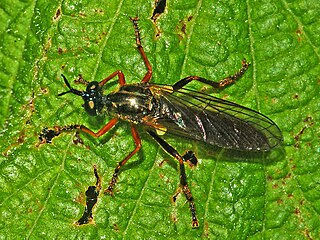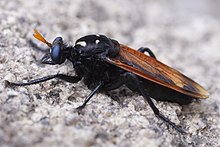
The Asiloidea comprise a very large superfamily insects in the order Diptera, the true flies. It has a cosmopolitan distribution, occurring worldwide. It includes the family Bombyliidae, the bee flies, which are parasitoids, and the Asilidae, the robber flies, which are predators of other insects.
Harold Oldroyd (24 December 1913 – 3 September 1978) was a British entomologist. He specialised in the biology of flies, and wrote many books, especially popular science that helped entomology to reach a broader public. His The Natural History of Flies is considered to be the "fly Bible". Although his speciality was the Diptera, he acknowledged that they are not a popular topic: "Breeding in dung, carrion, sewage and even living flesh, flies are a subject of disgust...not to be discussed in polite society". It was Oldroyd who proposed the idea of hyphenating the names of true flies (Diptera) to distinguish them from other insects with "fly" in their names. Thus, the "house-fly", "crane-fly" and "blow-fly" would be true flies, while the "dragonfly", "scorpion fly" and so on belong to other orders. He also debunked the calculation that a single pair of house-flies, if allowed to reproduce without inhibitions could, within nine months, number 5.6×1012 individuals, enough to cover the Earth to a thickness of 14.3 m (47 ft). Oldroyd calculated that such a layer would only cover Germany, but remarked "that is still a lot of flies".

The Asilidae are the robber fly family, also called assassin flies. They are powerfully built, bristly flies with a short, stout proboscis enclosing the sharp, sucking hypopharynx. The name "robber flies" reflects their expert predatory habits; they feed mainly or exclusively on other insects and, as a rule, they wait in ambush and catch their prey in flight.
The Manx robber fly is one of 7,100 species of robber fly or Asilidae known throughout the world, and one of 28 asilids known to occur in the British Isles.

Laphria is a genus described by Johann Wilhelm Meigen in 1803, belonging to the family Asilidae, subfamily Laphriinae. Members of this genus are known as bee-like robber flies. This genus has a Holarctic distribution, occurring in Europe, Asia, and North America. They prey on a variety of insects, including other robber flies, bees, wasps and beetles. Like other asilids, they use their proboscis to penetrate the body of their prey and inject enzymes which dissolve the tissues.

Efferia is an insect genus of mainly neotropical and nearctic Diptera in the family Asilidae or robber flies. It is one of the most species-rich genera of Asilidae, with particularly high diversity in arid or semi-arid ecosystems of the New World.

Diogmites is a genus of mainly neotropical flies in the family Asilidae or robber flies.

Alcimus is a genus of flies in the family Asilidae, the robber flies and assassin flies. There are about 26 species which are native to the Afrotropics.

Neoitamus cyanurus, the common awl robberfly, is a species of 'robber fly' belonging to the family Asilidae.

Neoitamus melanopogon, commonly known by the name common robber fly, is a species of fly of Asilidae in the genus Neoitamus, found in both the principal islands of New Zealand.

Holcocephala is a genus of robber flies in the family Asilidae. There are at least 40 described species in Holcocephala.
Bactria is a genus of robber flies in the family Asilidae. There are at least three described species in Bactria.
Lecania is a genus of robber flies in the family Asilidae. There are about five described species in Lecania.

Mallophora bomboides, also known as the Florida bee killer, is a predaceous species of robber fly of the family Asilidae that feeds primarily on bumblebees. M. bomboides is a noteworthy instance of Batesian mimicry given its close resemblance to its prey, the bumblebee. These bees are typically found in the Eastern and Southern regions of the United States like South Carolina and Florida.

Cerotainia is a genus of robber flies in the family Asilidae. There are at least 30 described species in Cerotainia.

Prolepsis tristis is a species of robber flies.

Dioctria rufipes, the common red-legged robberfly, is a species of robber fly in the subfamily Dasypogoninae of the family Asilidae.
Mallophora ruficauda is a species of parasitic robber fly in the family Asilidae, endemic to South and Central America. Like other robber flies, M. rauficauda is known for its aggressive behavior and predation upon other insects, especially bees. M. ruficauda mimics a bumblebee to fool predators into thinking it has a painful sting and is not worth eating.

Hyperechia is a genus of robber flies in the family Asilidae. They appear large, stout and with legs covered in bristles and appear like carpenter bees in the genus Xylocopa and the resemblance is considered as a case of aggressive mimicry, providing protection from predators. The larvae of the fly feed on the larvae of Xylocopa within their cavity nests in wood. They are mainly found in the African and Madagascan region with about 15 species and two species in Asia.

















